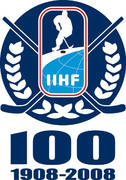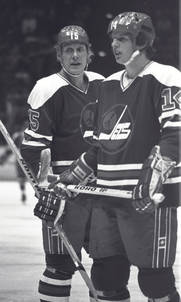Story #80
September 1974 – Winnipeg, Canada
Although Swede Thommie Bergman was signed by the Detroit Red Wings in 1972 and his countrymen Borje Salming and Inge Hammarstrom joined the Toronto Maple Leafs one year later, Europeans in the NHL were few and far between in the early 70s. And apart from Salming, they didn't have much impact and the tough Swede was seen as an exception to the rule that said that you can't build a team around Europeans.
All that changed in 1974 when the World Hockey Association started to systematically sign Europeans, mostly Swedes and Finns who were easily accessible. When the WHA was introduced in 1972, the rebel league was dominated by the New England Whalers and the Houston Aeros who only had North American players. In Winnipeg, general manager Rudy Pilous and coach Bobby Kromm realized that courting European might be the way to WHA dominance. How right they were. It started with Swedes Anders Hedberg and Ulf Nilsson joining in 1974 and the flashy Scandinavians formed one of the most exciting lines in professional hockey teaming up with legend Bobby Hull. Hedberg had 53 goals in his rookie season while Nilsson set rookie records with 94 assists and 120 points.
It was during that season that the North American hockey establishment realized that players from the other side of the pond could play dominating roles. The Jets were on their way to greatness and with nine (!) Europeans – including Swedish captain Lars-Erik Sjoberg – Winnipeg won the WHA championship, the Avco Cup, the next season. The 1974-75 was a milestone season for European migration to North America. The WHA would only live for three more seasons before it merged with the NHL, but the Euro-stocked Jets won in two out of the three years.
The WHA and the Winnipeg Jets had immense influence on the future of pro hockey in Canada and the United States. Closely watching the free-wheeling style of the Jets, coach Glenn Sather in Edmonton started to build his upstart Oilers by emulating Winnipeg's European oriented approach. As soon as the WHA folded in 1979, the NHL raided the defunct clubs for European talent.
Hedberg, Nilsson and Sjöberg joined the New York Rangers. Their cross-town rivals, the New York Islanders, won four Stanley Cups (1980-83) with four Swedish players, becoming the first NHL-club to have Europeans on their winning team. Another Swedish Jet, Willy Lindstrom, went to the Oilers and assisted Wayne Gretzky in winning Stanley Cups in the mid-80s.
There is no doubt that the WHA's and the Winnipeg Jets' coveting European players in the mid-70s contributed to changing the North American game.
As part of the IIHF's 100th anniversary celebrations, www.IIHF.com is featuring the 100 top international hockey stories from the past century (1908-2008). Starting now and continuing through the 2008 IIHF World Championships in Canada, we will bring you approximately three stories a week counting down from Number 100 to Number 11.
The Final Top 10 Countdown will be one of the highlights of the IIHF's Centennial Gala Evening in Quebec City on May 17, the day prior to the Gold Medal Game of the 2008 World Championship.
These are the criteria for inclusion on this list: First, the story has to have had a considerable influence on international hockey. Second, it has to have had either a major immediate impact or a long-lasting significance on the game. Third, although it doesn't necessarily have to be about top players, the story does have to pertain to the highest level of play, notably Olympics, World Championships, and the like. The story can be about a single moment — a goal, a great save, a referee's call — or about an historic event of longer duration — a game, series, tournament, or rule change.
|










